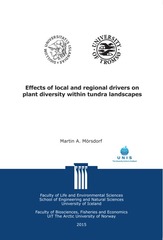Effects of local and regional drivers on plant diversity within tundra landscapes
Permanent lenke
https://hdl.handle.net/10037/8661Åpne
Thesis introduction (PDF)
Definition of sampling units begets conclusions in ecology: the case of habitats for plant communities. Mörsdorf MA et al. Also available in PeerJ 3(3): e815 (PDF)
Topography drives patterns of tundra plant diversity – there is no difference, even 60 years after cessation of sheep grazing. Mörsdorf MA. et al. (Manuscript) (PDF)
Species pool size alters the diversity patterns shaped by local forces - an example from the tundra. Mörsdorf MA. et al. (Manuscript) (PDF)
Thesis entire (PDF)
Dato
2015-12-21Type
Doctoral thesisDoktorgradsavhandling
Forfatter
Mörsdorf, Martin AlfonsSammendrag
In tundra, the diversity within vascular plant communities (alpha diversity) is known to be determined by local drivers such as habitat productivity and ungulate grazing. However, little is known how such local drivers modify the diversity between communities (beta diversity). Furthermore, diversity patterns may be constrained by the size of the regional species pool, which in turn may mediate the effects of local drivers. Until now, these interactions have not been addressed in tundra habitats. The aim of this thesis was therefore to assess how local and regional drivers shape diversity patterns in tundra.
The thesis comprises three separate, but closely related studies. Firstly, to achieve comparability between studies, different methods of defining habitats for diversity assessments were evaluated. The results highlighted the importance of defining habitats explicitly. Alpha and beta diversity were assessed in Icelandic tundra valleys at several spatial scales, determined by topography, and contrasting regimes of sheep grazing. The same study design was applied at comparable locations in Norway, a mainland region with a greater species pool size than Iceland.
Diversity in Iceland was strongly driven by topography of contrasting landform curvature and elevation, representing different conditions of habitat productivity. Diversity was not affected by current contrasts in sheep grazing which is likely due to the persistence of historical grazing effects. Topography within Norway displayed similar effects, however, the comparison to Iceland provided the first evidence that a large species pool size may amplify diversity patterns that are shaped by local topography.
The thesis also highlights the importance of clarity and unambiguity when defining spatial scales for assessments, the appropriate diversity measures, and the levels of biological organization to be used. A clear definition concerning those aspects is essential when inferring effects of local and regional driving forces on vascular plant diversity within tundra.
Forlag
UiT The Arctic University of NorwayUiT Norges arktiske universitet
Metadata
Vis full innførselSamlinger
Copyright 2015 The Author(s)
Følgende lisensfil er knyttet til denne innførselen:


 English
English norsk
norsk
